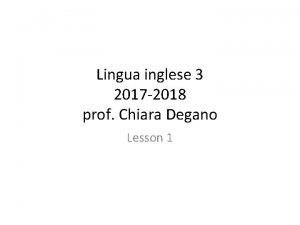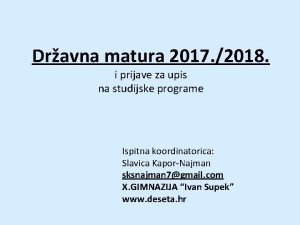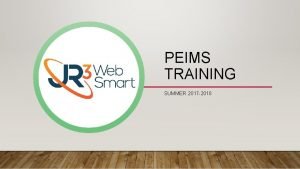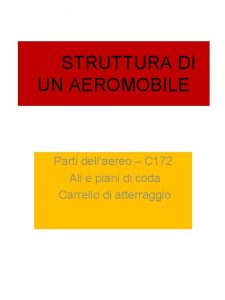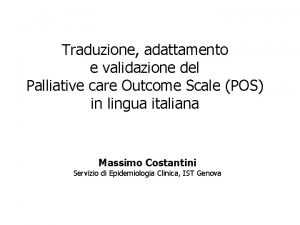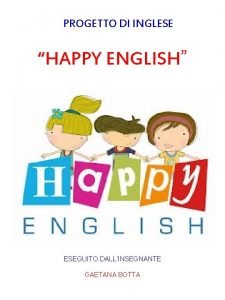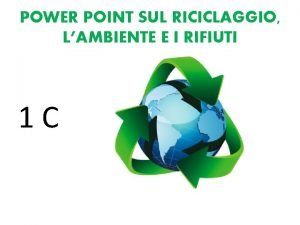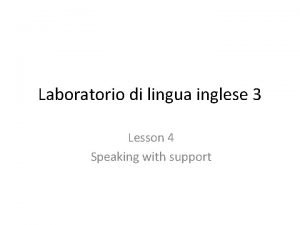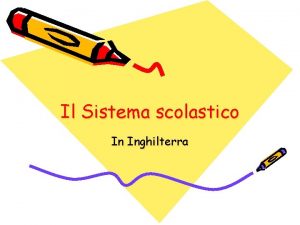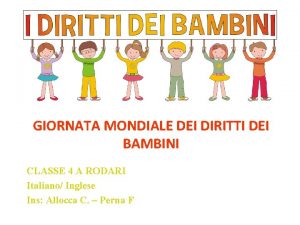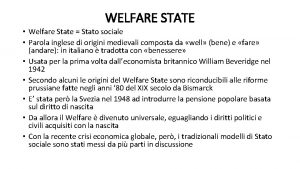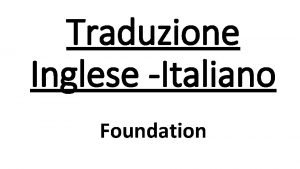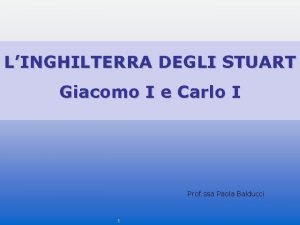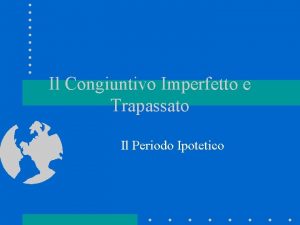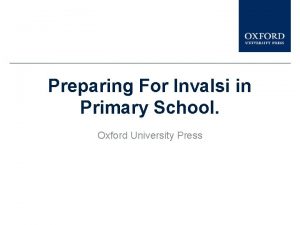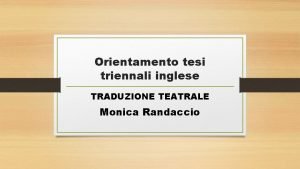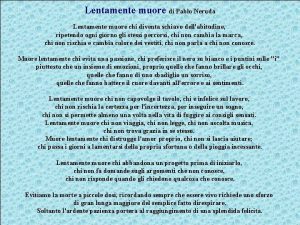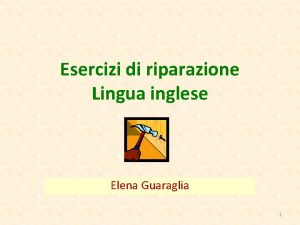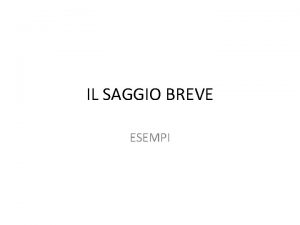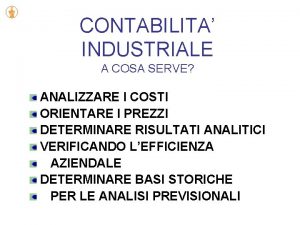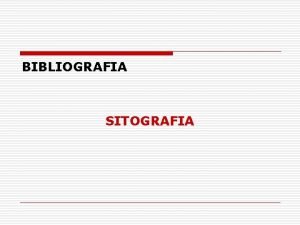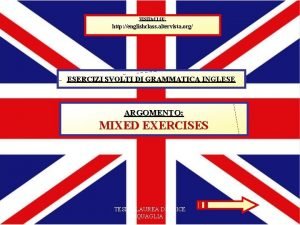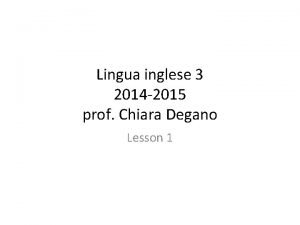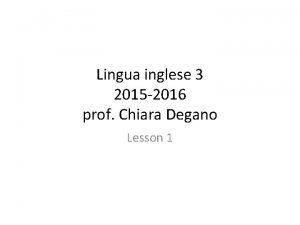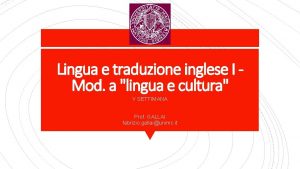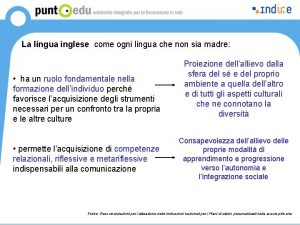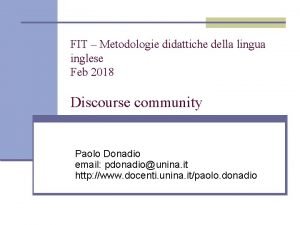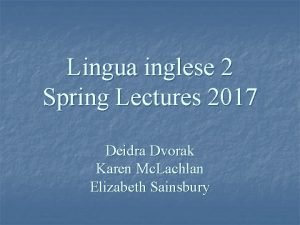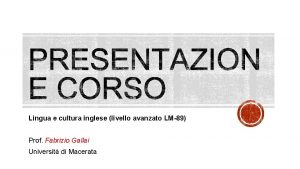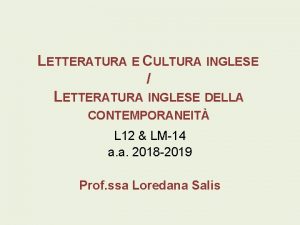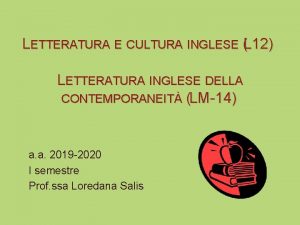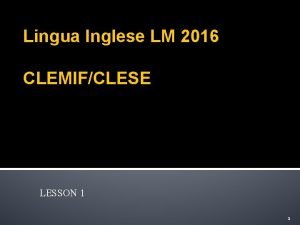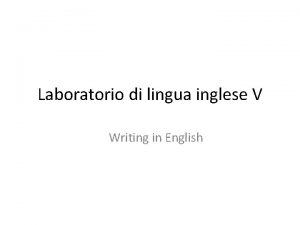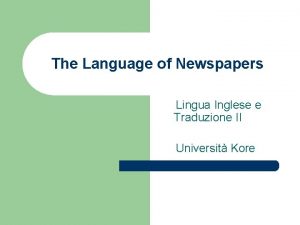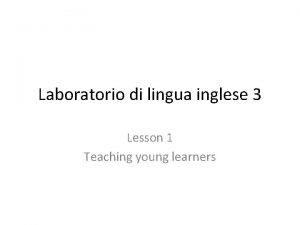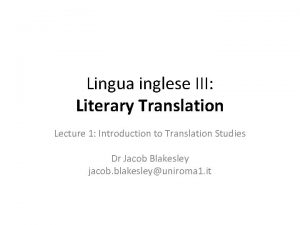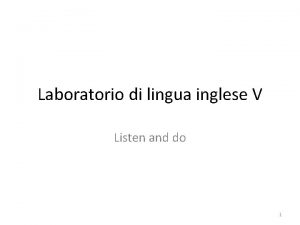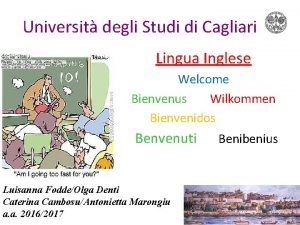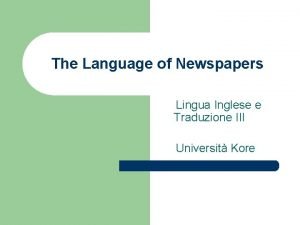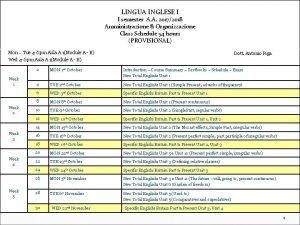Lingua inglese 3 2017 2018 prof Chiara Degano
























- Slides: 24

Lingua inglese 3 2017 -2018 prof. Chiara Degano Lesson 1

Organizzazione • Ricevimento – Giovedì 10, 30 -12, 30 stanza 23. Controllare modifiche sulla pagina docente del sito di Macroarea • Lettorati – Gruppo A (A. Smith) – Gruppo B (da definire) – Traduzione italiano-inglese - gruppo A (A. Smith) – Traduzione italiano inglese – gruppo B (da definire)

Modulo • Il corso offre un’introduzione sia teorica sia pratica alla traduzione di testi specialistici appartenenti a generi diversi, in ambiti quali il discorso economico-commerciale (ivi compreso il turismo), scientifico e dei media. In particolare, verranno affrontati alcuni problemi traduttologici fondamentali, prendendo in analisi livelli linguistici diversi quali quello terminologico, lessico-grammaticale, sintattico e discorsivo. Particolare attenzione verrà riservata all’uso di risorse online a supporto della traduzione quali glossari e corpora.

Valutazione modulo (esame finale) • Parziale (esonero) – Prova di traduzione inglese-italiano e italiano-inglese • Orale – Modalità 1 Domande su • teoria della traduzione • strategie di traduzione • strutture morfo-sintattiche della lingua inglese • La docente potrà inoltre chiedere allo studente di leggere ad alta voce (in inglese) e tradurre a vista dall’inglese all’italiano – Modalità 2 • • Progetto di traduzione 400 -500 parole, testo specialistico/divulgativo Corredato da schermate di ricerche fatte online o sul altre fonti Discussione su difficoltà/ strategie

Bibliografia • Laviosa, Sara 2008. “Linking Wor(l)ds”. Lexis and Grammar for Translation Studies. Napoli: Liguori Editore. • Laviosa, Sara 2012. “Corpus linguistics in translation studies”. In Carmen Millan-Varela and Francesca Bartrina (eds. ) Routledge Handbook of Translation Studies. London and New York: Routledge. 239 -251. • Garzone, Giuliana 2002. Observations on the definition of translation. In University Translation Studies (3 rd edition), Fedorov Readings III. Proceedings of the 3 rd annual International Conference on Translation Studies, St. Petersburg 26 -28 October 2001. pp. 140159.

• Job interview • Translation into Italian?

https: //www. dropbox. com/s/736 ez 18 guns 92 w 6 /Screenshot%202017 -1002%2011. 49. 58. png? dl=0

Intervista di lavoro?

• Neighborhood restaurant • Translation into Italian?

• Ristorante di quartiere? • Other options? Ø Native speaker competence not always enough (specialised jargon/new concepts) Ø Problem of equivalence

Reflection on translation • For centuries, theoretical reflection on translation has focussed on the problem of equivalence of the Target Text (TT) with the Source Text (ST). • A number of bi-polar oppositions have been formulated: – – – Literal-free Faithful-unfaithful Overt – covert (House 1981) Formal correspondence vs dynamic equivalence (Nida-Taber 1969) Semantic vs communicative translation (Newmark 1981) Actualization vs historicisation / domestication vs foreignization (Venuti 1995) • Opposition not resolved but overcome, as theoretical reflection has moved up to a higher level of speculation, addressing the complexity of language in use as a stratified semiotic system

• When dominated by the concern for equivalence, the dabate on translation focussed on lexico-grammatical problems (parallel to the development of linguistics) • Starting from Saussure, the scope of linguistics expanded to encompass higher levels of signification and communication, leading to a stratified conception of language

Language as a multi-level semiotic process Semantic Pragmatic/communicative Cultural Esthetic Lexico-grammatical encoding/decoding The basic level of linguistic (lexico-grammatical) encoding/decoding is dominated by the higher levels

• The meaning of a sentence is only partly expressed explicitly (i. e. linguistically codified), therefore retrievable in the text • The implici part is reconstructed through inference, relying on data relevant to each communicative act, and on conceptual data.

An example • There is no electricity in the Feather Down Tent itself, so to create the right luxury camping atmosphere within, we use romantic oil lamps and candles. Electricity sockets are nearby at the honesty shop or shower block to, for example, charge your phone.

• Feather Down offers you the ideal ingredients for camping on your farm holidays: A living space of 45 m 2 3 bedrooms Proper beds with comfy mattresses A fully equipped kitchen with cold running water tap • A flushing toilet • Solid wooden floor boards throughout • •

Which would be the best trasnlation for a camping brochure/website? • WC attaccato alla fogna • WC con sciacquone • Bagno interno/privato …And why?

• Early ’ 80 s: turning point • Shift of perspective: from prescriptive to descriptive/functionalist approach. • The relation between the TT and the ST looses centrality (dethronement of the ST) common to functionalist and descriptive approaches

Functionalist approach • Mainly concerned with non-literary texts • Translation choices depend on the purpose the TT is meant to have in the target language community • equivalence is supplanted by adequacy: the TT should function adequately in the target culture • Hans Vermeer /Katarina Reiss (1984)

Descriptive translation studies • Equivalence is no more conceived in absolute terms: it varies across time and space. • In the target culture the translated text becomes part of its polysystem and functions in relation to the structure of the receiving culture • E. g. the Holy Bible has played an important role in Western cultures irrespectively of their degrre of (in)accuracy in rendering the ST. (Toury 1991)

Another example: • Alexander Pope’s vs William Cowper’s translation of the Iliad • Pope’s version purged of elements alien to the sensitivity of XVIII century England (crude reference to wounds, dismemberment…) • Cowper’s version is less popular, and ‘fuctions’ less in the TC (less pleasant to read) but more accurate in rendering Homer’s world and values.

• In both functionalist and descriptive approaches, contextual and cultural considerations prevail over linguistic/contrastive concerns. • Linguistic facts receive hardly any attention • However, they have had the merit of shifting attention from the lower levels of semiosis (lexico-grammatical encoding) to higher levels, which govern the whole process.

• As a consequence of this shift of perspective, more than one translation project might be legitimate, depending on the use it will be put to. • E. g. insurance contract: • If used for the stipulation of contracts in foreign countries: “legal” equivalence (target-language oriented approach); • If used as court evidence, coming as a parallel text: source-language oriented approach.

• In Language for Special Purposes translators are required to produce TL texts that read naturally, i. e. that sound like TL originals.
 Chiara degano
Chiara degano Matura 2018/19
Matura 2018/19 Tsds peims 2017 2018
Tsds peims 2017 2018 Dada la siguiente secuencia rusia 2018 rusia 2018
Dada la siguiente secuencia rusia 2018 rusia 2018 Struttura di un aereo
Struttura di un aereo Hospice traduzione
Hospice traduzione Eseguito in inglese
Eseguito in inglese Powerpoint sul riciclo
Powerpoint sul riciclo Speaking inglese
Speaking inglese Sistema scolastico inglese
Sistema scolastico inglese Global warming in inglese
Global warming in inglese I diritti dei bambini in inglese
I diritti dei bambini in inglese Stato sociale in inglese
Stato sociale in inglese Tecniche traduzione inglese
Tecniche traduzione inglese Affermative tense
Affermative tense Dibattiti di putney schema
Dibattiti di putney schema Periodo ipotetico italiano
Periodo ipotetico italiano Ready for practice tests invalsi
Ready for practice tests invalsi Traduzione
Traduzione Pablo neruda poema muere lentamente
Pablo neruda poema muere lentamente Riordinare in inglese
Riordinare in inglese Esempio di saggio critico
Esempio di saggio critico Contabilità industriale in inglese
Contabilità industriale in inglese Bibliografia e sitografia in inglese
Bibliografia e sitografia in inglese Condizionali inglese
Condizionali inglese
